The story behind creating the Menu Item Extras module began when we worked on complex menus in our projects, but the Menus in the Drupal 8 release still did not have fields. However, there were so many modules in Drupal 7 that helped us build mega menus.
We did extensive research into menu implementation in Drupal 8, and surprisingly, we found out that menu items in Drupal 8 were entities, and any entities in Drupal 8 could have fields. Yet, the existing modules and the Drupal core did not use entities to add fields. Modules usually use additional entity types or menu item attributes to store data from attached fields.
Menu Item Extras background
As we found out, the Drupal core has a weak and inflexible implementation of the Menu Link Content entity type. Core services for menus were too big and complex, the bundle was hardcoded, the service provided no integration with other modules, and the template suggestions were lacking. That was an epic issue, so we decided to fix it and develop a new Drupal module.
We didn’t want just to add fields for menu items. We wanted to give website admins and developers a useful module with an intuitive administration interface and clear code. We aimed to deliver a high-quality Menu Item Extras module to the Drupal community to demonstrate how powerful Drupal 8 and its following versions are.
Before the development of each new feature, we had long meetings and discussions with our team of one front-end and three back-end developers. After 3 weeks of development, we released the Drupal Menu Item Extras module, which has been downloaded 100,000+ times as of January 2019. Our Drupal team updated the Menu Item Extras module, making it compatible with the Drupal 9 and 10 versions. As of January 2024, more than 32K websites report using the module.
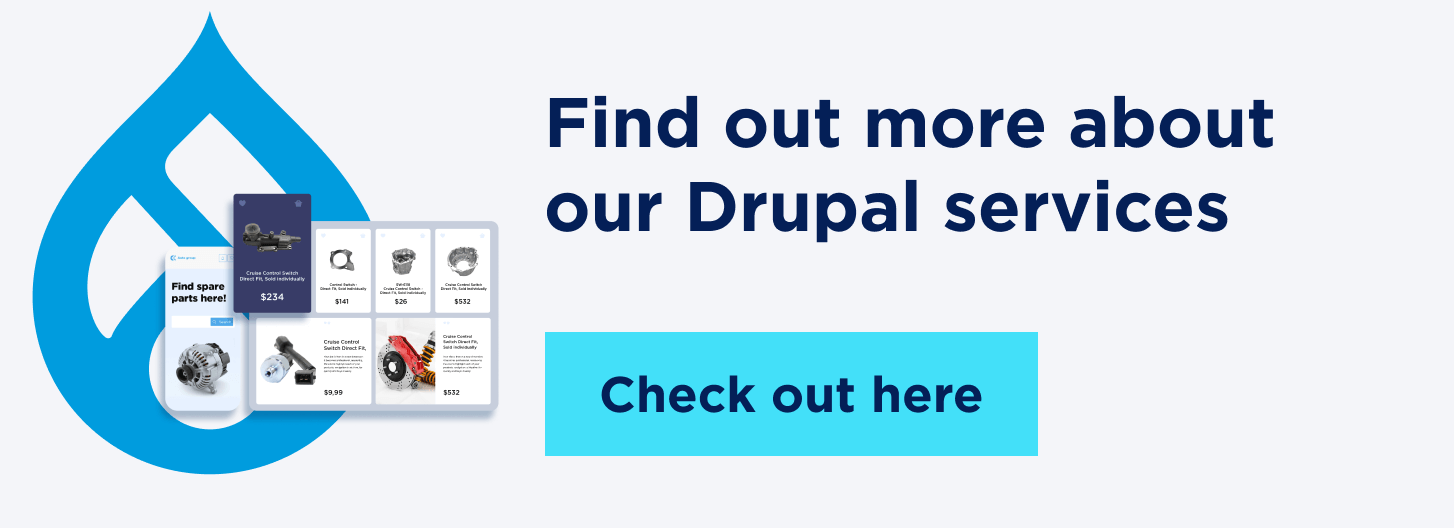
How it works
Menu Item Extras makes the Menu Link Content entity fully fieldable. The module fixes core issues and provides a couple of features, like Demo Module and View mode per menu item, which makes developers' lives easier. It allows us to use each Drupal menu fields type for menus as for the normal Drupal 8 entity. Each menu is a bundle for the Menu Link Content.
The core bundle is hard coded to `menu_link_content`
Drupal\menu_link_content\Entity\MenuLinkContent::preCreate
/**
* {@inheritdoc}
*/
public static function preCreate(EntityStorageInterface $storage, array $values) {
$values += ['bundle' => 'menu_link_content'];
}To avoid changing the menu item bundle, the module blocks the ability to set a parent link from other menus. So, in the Parent Link field, you will see links from the current menu only (see menu_item_extras_form_menu_link_content_form_alter). However, we’re not sure if anyone uses it at all.
Demo module
This module has a submodule `mie_demo_base` for demonstrating base features. There, you can find a new menu, “Menu Item Extras Demo Menu,” with added fields and overridden templates.
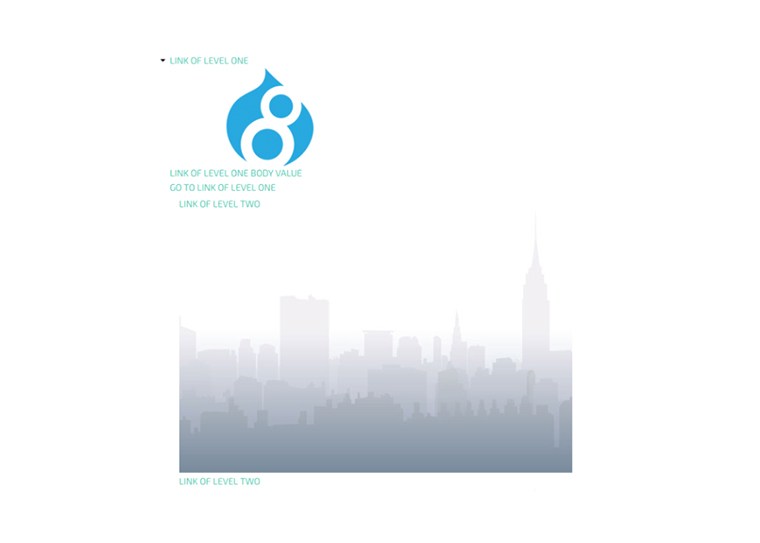
View mode per menu item
Each menu item has a new field called “View mode.” For each menu item, you can set a specific view mode (e.g., teaser, banner, etc.). This field is available when you add at least one field to the menu.
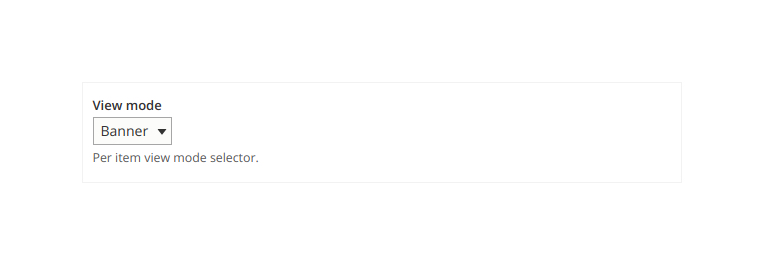
You can add view modes for Menus from the default page with view modes for all entity types.
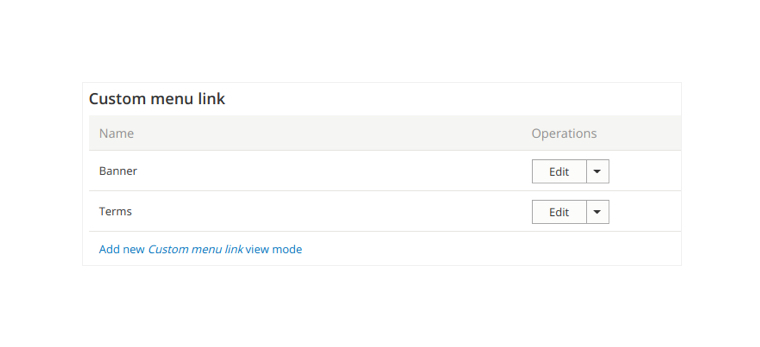
Menu Item Extras provides an additional overview page with a list of all menu items and their view modes.
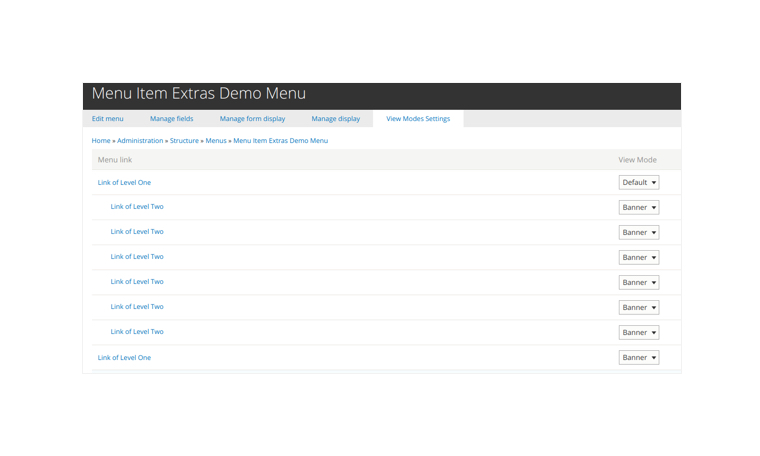
Since each menu item could have child items, the module provides an extra field “Children” on the manage display.
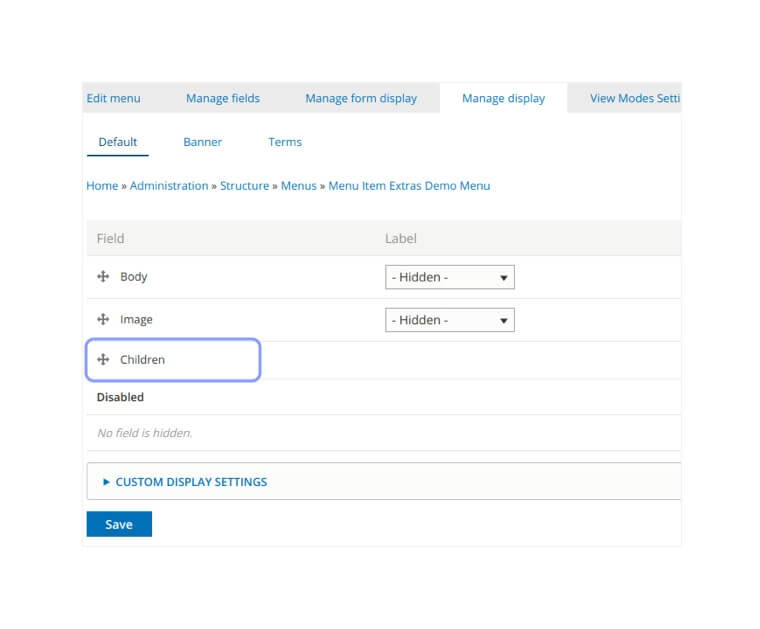
Views integration
Since we have a normal Drupal entity for the menu items, we can use it via views. By default, the core Menu Link Content entity type doesn’t work with views. Menu Item Extras fixes this issue as well (see menu_item_extras_entity_type_build).
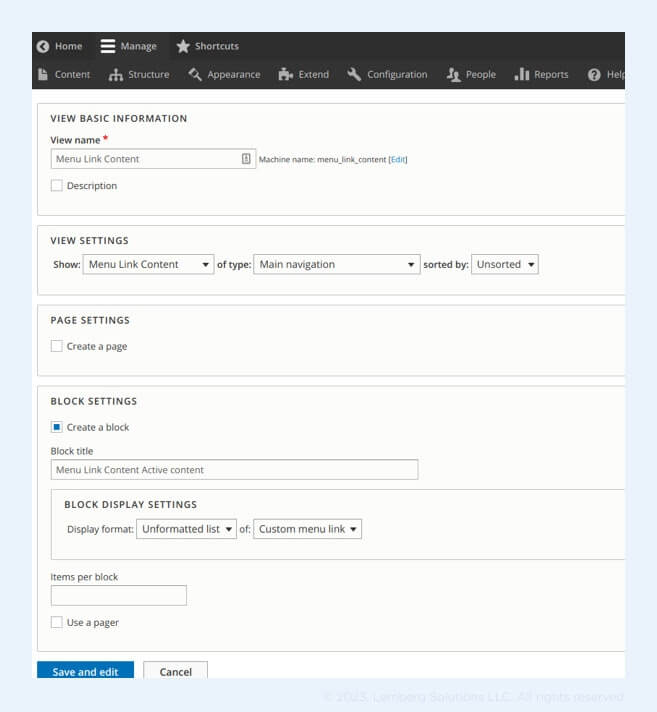
One of the use cases is the active menu item content in a separate region. To implement this, you have to use a contextual filter with Entity ID and default value type “Active menu item ID,” which is also provided by this module.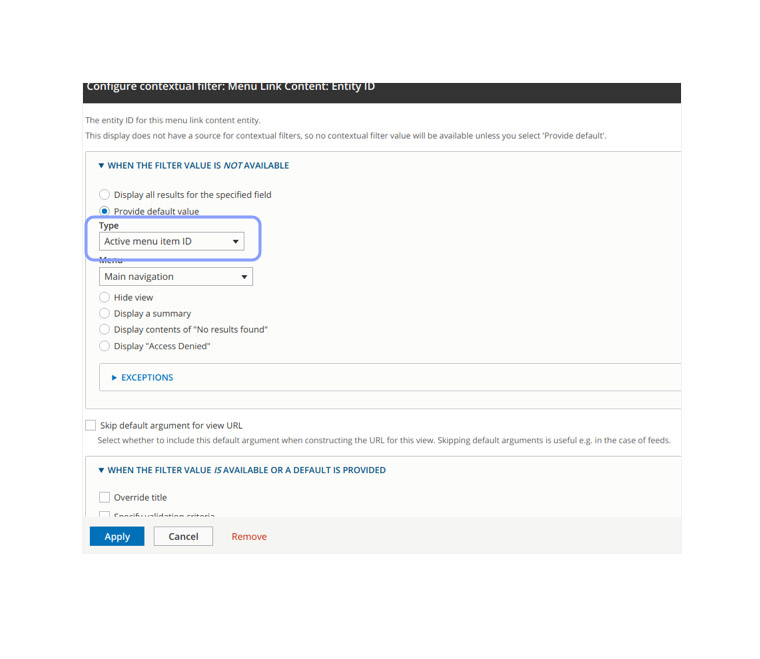
Now, we can place our views block in the region and see what we get.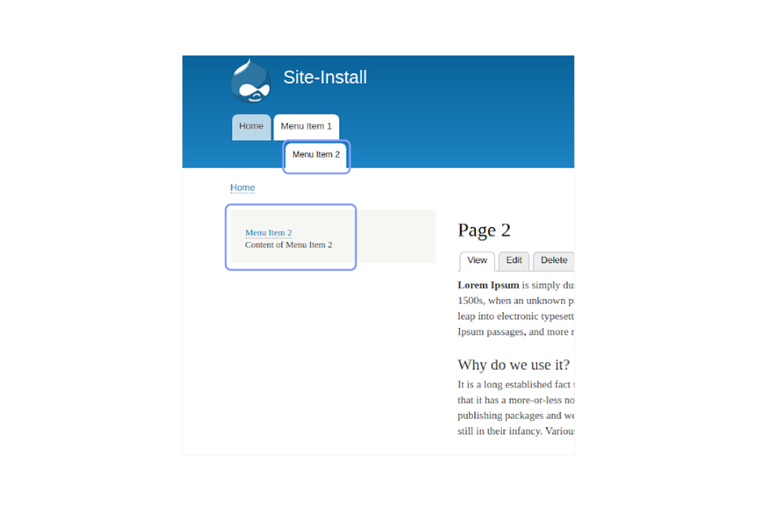
Menu template suggestions
Menu Item Extras extends template suggestions for the menus. Here, you can check suggestions for the Main menu in the Primary menu region:
<!-- FILE NAME SUGGESTIONS:
* menu--extras--main--primary-menu.html.twig - region related (extra)
* menu--extras--main.html.twig - menu name related(extra)
x menu--extras.html.twig - default template from the module(extra)
* menu--main.html.twig - global template
* menu.html.twig - global template
-->Inside the menu template, we render menu items levels and add suggestions for each level starting with 1; the main level with ID 0 is skipped:
<!-- FILE NAME SUGGESTIONS:
* menu-levels--main--level-1.html.twig
* menu-levels--main.html.twig
x menu-levels--level-1.html.twig
* menu-levels.html.twig
-->Inside the menu level, we render the Menu Link Content entity with all added fields. This is a new theme. It renders only the entity with fields but without menu item links.
<!-- FILE NAME SUGGESTIONS:
* menu-link-content--main--standard.front-page--default.html.twig
* menu-link-content--main--standard.front-page.html.twig
* menu-link-content--main--menu-level-0--default.html.twig
* menu-link-content--main--menu-level-0.html.twig
* menu-link-content--menu-level-0.html.twig
* menu-link-content--main--default.html.twig
* menu-link-content--main.html.twig
* menu-link-content--default.html.twig
x menu-link-content.html.twig
-->Since the Drupal menu system uses recursion to render children, inside the menu-link-content.html.twig, we have menu-levels.html.twig, and it repeats until the last child.
This is an illustration of the hierarchy of templates and how they are rendered.
Inside the menu-link-content.html.twig, we have an additional variable show_item_link. This variable is used to render the Menu Item Link inside the entity template. By default, Menu Item Link is rendered in the menu-level.html.twig template. By default, this variable is set to FALSE, and we can use `hook_preprocess_menu()` to change it.
How to use the Menu Item Extras module
Below, we provide detailed guidelines on how to install and configure the Drupal Menu Item Extras module for your website.
To install the module, download and enable it as a usual module. Then, go to the menus list and edit the menu in which you want to have the extras.
Module configuration:
- You can enable/disable extras per menu. By default, we enable extras for the Main Menu. When extras are disabled, all data from the fields is removed.
- We created more suggestions for menus in regions. You could change the menu template per region.
For example:
menu--extras--main--header.html.twig
menu--extras--main--footer.html.twig
Benefits of Menu Item Extras module
Our team continuously works on the Menu Item Extras module, adding new features that extend the list of the module’s benefits. Apart from such benefits as a Drupal responsive menu and control per menu item with a View mode, below, you can find the list of features we added to bring you even more value:
- Fully fieldable menu Link Content entity
- Fixed templates for more comfortable use
- Update path from the 1.x to 2.x
- Support views
- Demo modules which will demonstrate the power of this module, and what magic you can do with it. Try it yourself at Simplytest.me
- Fixed issues in the core module that made this module possible to develop.
Known issues and workarounds
If the menu does not have at least one field, the view modes field is not available on the Menu Item edit form. You can add an extra field and hide it on the manage form display.
It does not support MenuLinkDefault entities since it has a different entity type.
Other Drupal Modules for Menus: Brief Overview
Let’s review some of the other Drupal modules enabling you to structure your menu more efficiently:
Drupal Mega Menu
A Mega Menu is a module that simplifies the process of building a multi-level menu on a Drupal platform. It saves your time on creating and customizing complex menu navigation and brings users a better experience on your website.
Note that Drupal Mega Menu is not an alternative to the Menu Item Extras module, as the latter is a unique implementation of Drupal Core’s Menu system.
Superfish
The Superfish module lets you create a multi-level drop-down menu on your Drupal platform using the jQuery Superfish menu plugin. The module is especially useful if you are looking to build a large-scale menu.
Simplify Menu
The Simplify Menu module provides the ability to customize your menus and ensure they comply with all necessary standards. The module uses the TwigExtension to gain access to Drupal's Main Menu.
Responsive and off-canvas menu
The responsive and off-canvas menu integrates the menu library with the Drupal menu system to enable a wider width for horizontal menus on your Drupal platform. The module adjusts to your theme and helps you trigger your desired horizontal menu breakpoints.
Taxonomy Menu UI
The Taxonomy Menu UI module can be used to create menu items on a Taxonomy term page on your Drupal platform. The functionality of this module is similar to adding menu items for nodes. You can add or edit menu items and nodes using the module.
Conclusion
With Menu Item Extras, we get fieldable Drupal Menus and many extra features, which are helpful in building complex menus. We hope that in the future, Drupal Core will support fields by default, and our module will just provide awesome extra features for menu block Drupal.
If you are looking to develop your Drupal-based website, feel free to contact our experts.


